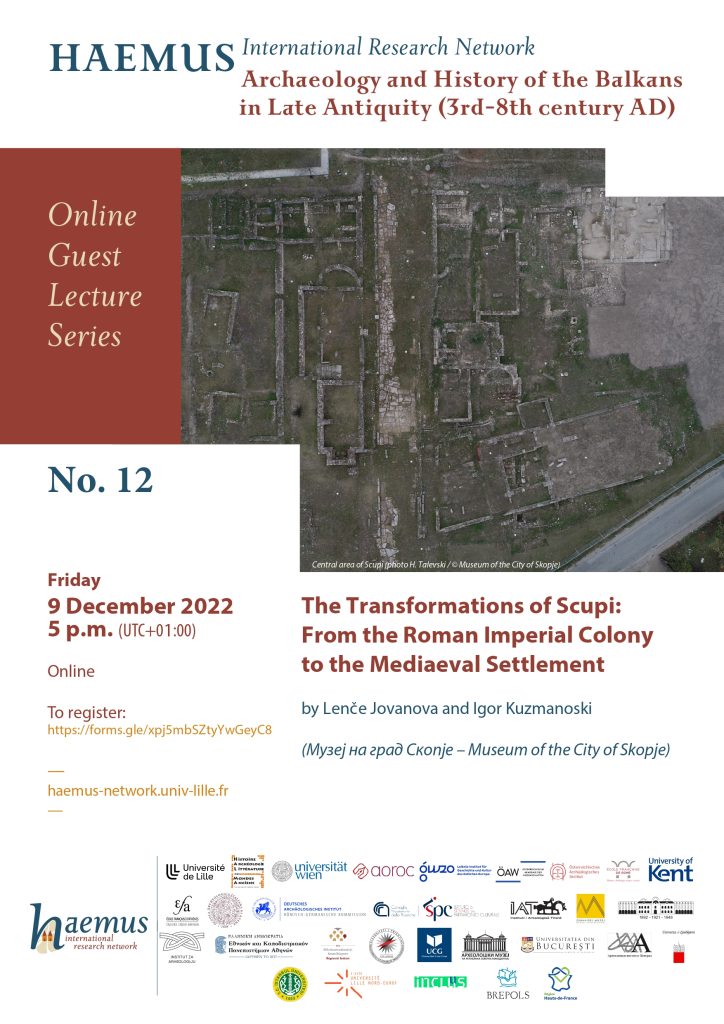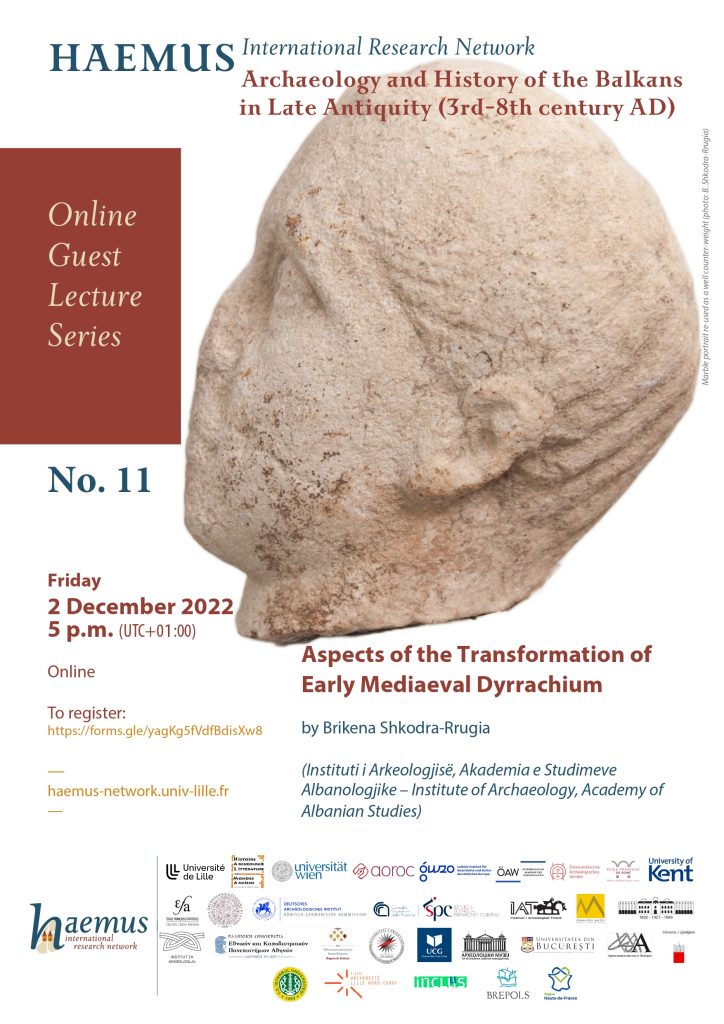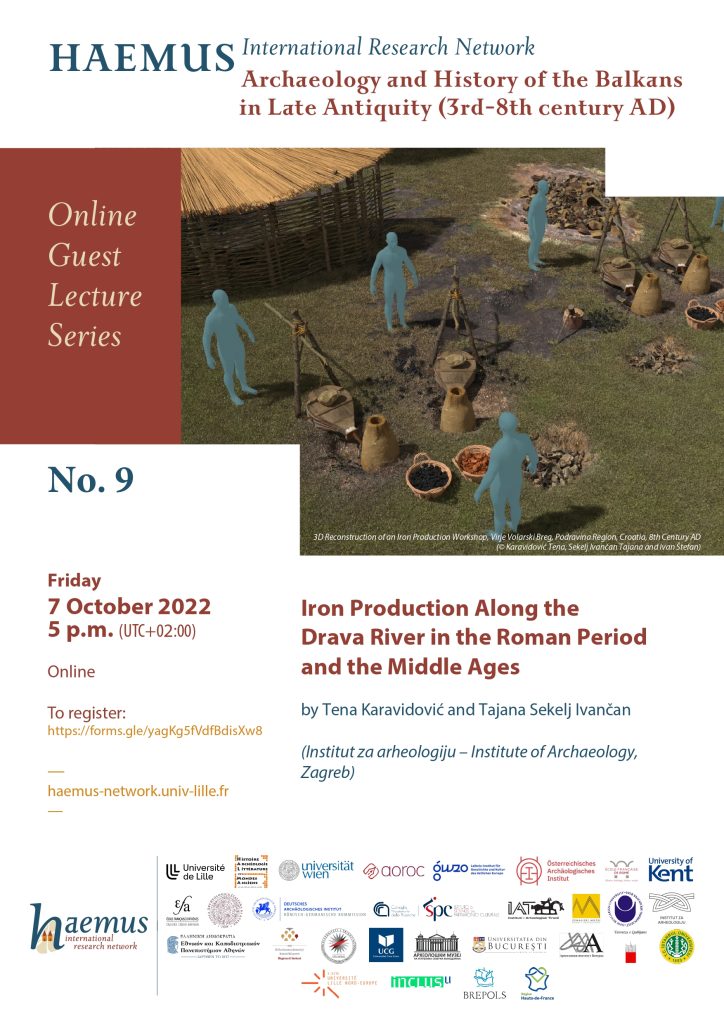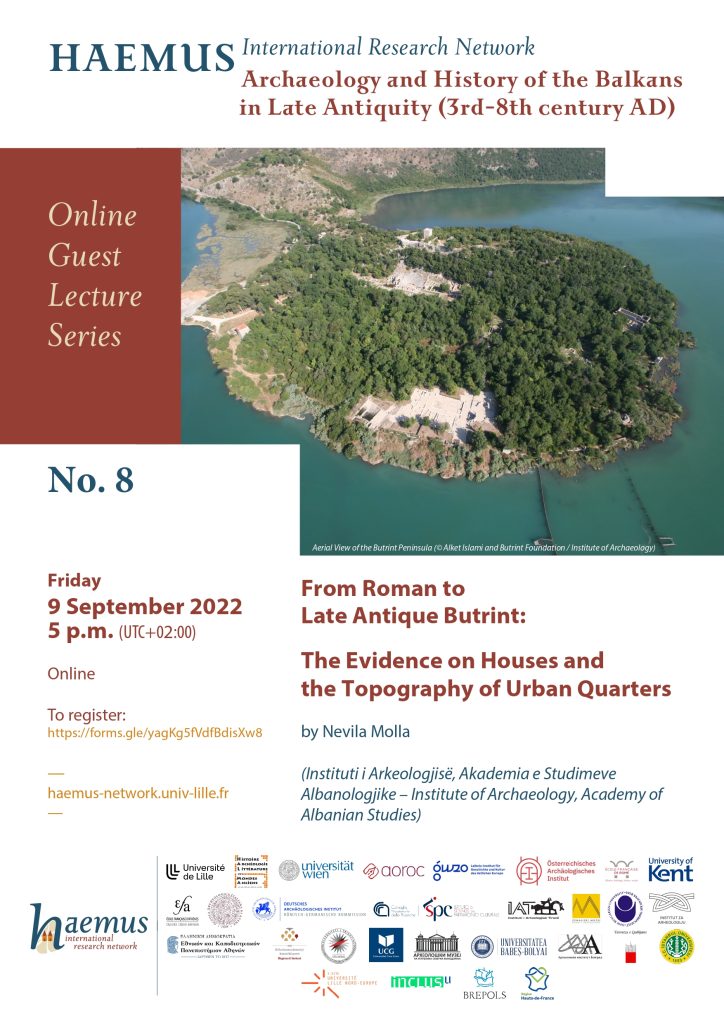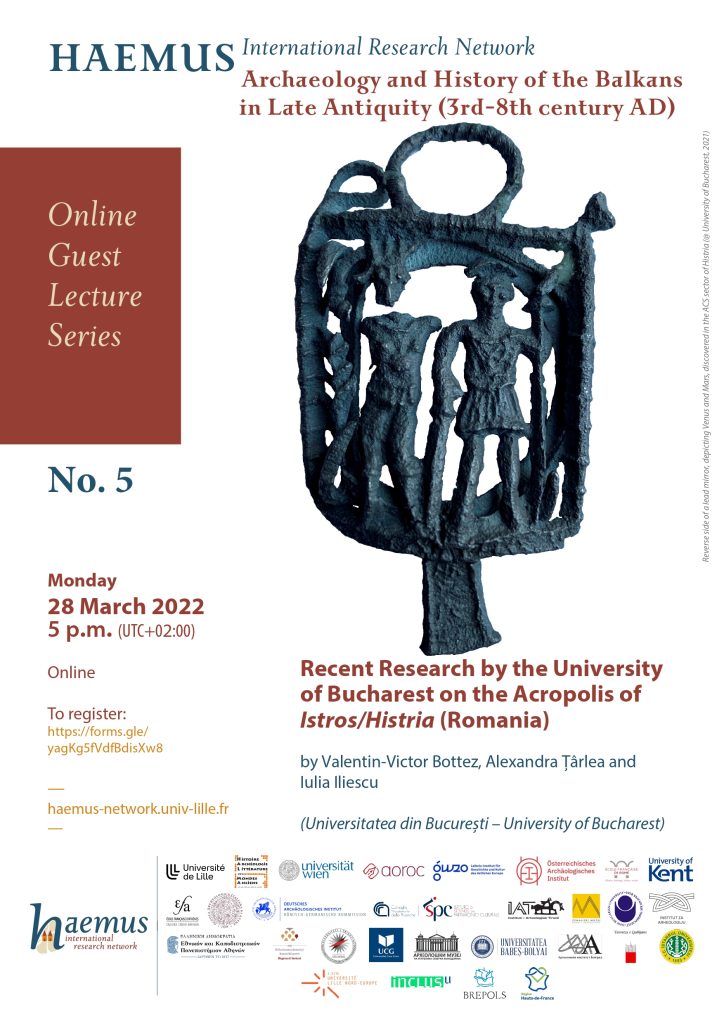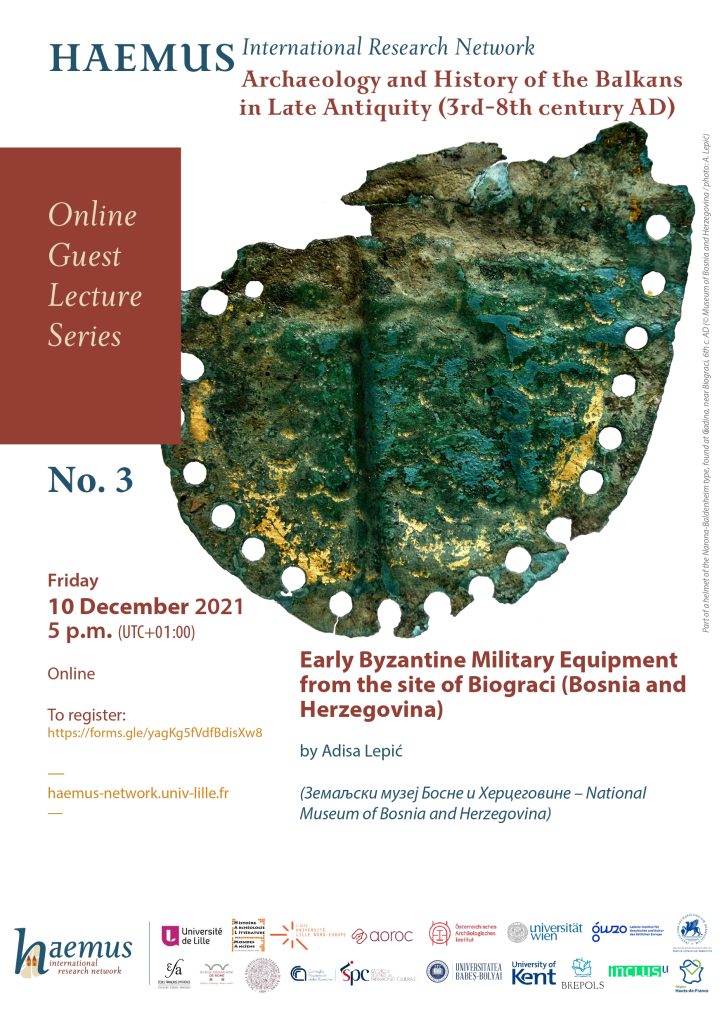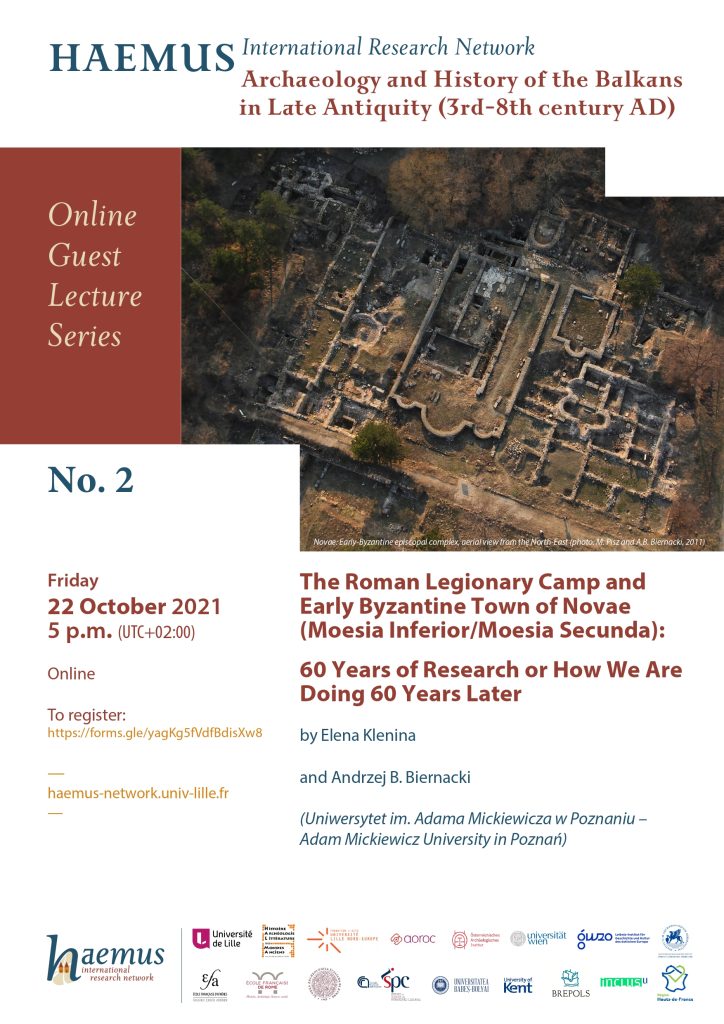For the academic year 2023-2024, the HEAMUS International Research Network has a special agreement with the Master's degree in Archaeology, Sciences for Archaeology (Archéologie, Sciences pour l'archéologie—ASA), options “Archaeology, Culture, Territory and Environment" (Archéologie, culture, territoire et environnement—ACTE), “Building Archaeology" (Archéologie du bâti—ARBA) and “Archaeology—Geo-Sciences" (Archéo-Géo-Sciences—AGES), of the Université de Franche-Comté and the Université de Bourgogne. The lectures will be screened for the students within the “Scientific English" (Anglais scientific) seminar. This Master's degree is attached to the SOPAST (Societies and Environments of the Past: Trajectories – Sociétés et environnements du passé : trajectoires) research topic of the Chrono-environnement-UMR 6249 Research Centre.
No. 23: Heraclea Sintica – The Archaeology of a Macedonian City, up to the End of Antiquity (13 May 2024)
by Lyudmil Vagalinski (Национален археологически институт с музей, Българска академия на науките – National Archaeological Institute with Museum, Bulgarian Academy of Sciences)
Abstract: The site of Heraclea Sintica is located in the Rupite region, on the land of the eponymous village in the municipality of Petrich, in south-west Bulgaria. It occupies mainly the southern slope of the Kozhuh elevation, known as Dzonkov peak (224 m), as well as the field to the south and west. In Antiquity, the city lay on the boundary between Thrace and Macedonia. The ancient city was founded by Macedonian colonists in the middle of 4th century BC, during the reign of Philip II of Macedon, in the lands of the Thracian tribe of the Sinti. From the middle of 2nd century BC, it belonged to the Roman province of Macedonia. Heraclea Sintica being located on one of the main roads leading to the southern Balkans, it was just as prosperous as it was subject to attacks from the north. But we had to wait two strong successive earthquakes, one at the end of the 4th century and one in the second quarter of the 5th century, to see the city finally destroyed. Long ignored by archaeologists, the remains of this exceptional site have been the subject of a series of investigations since 2007, carried out under the aegis of the National Archaeological Institute with Museum of the Bulgarian Academy of Sciences. The results obtained demonstrate an enviable adaptability in the changing political and economic framework over the centuries. Of course, this was also achieved by other ancient Macedonian cities. However, the case of the Heracleans is extraordinary, because it combined their flexibility with remarkable ethnic and cultural conservatism, at least until the Constitutio Antoniniana (AD 212). The centuries-old border location of the city requiring strong collective cohesion can represent a possible explanation of this social phenomenon, and this is what this paper will attempt to demonstrate, relying on the results obtained through field work.
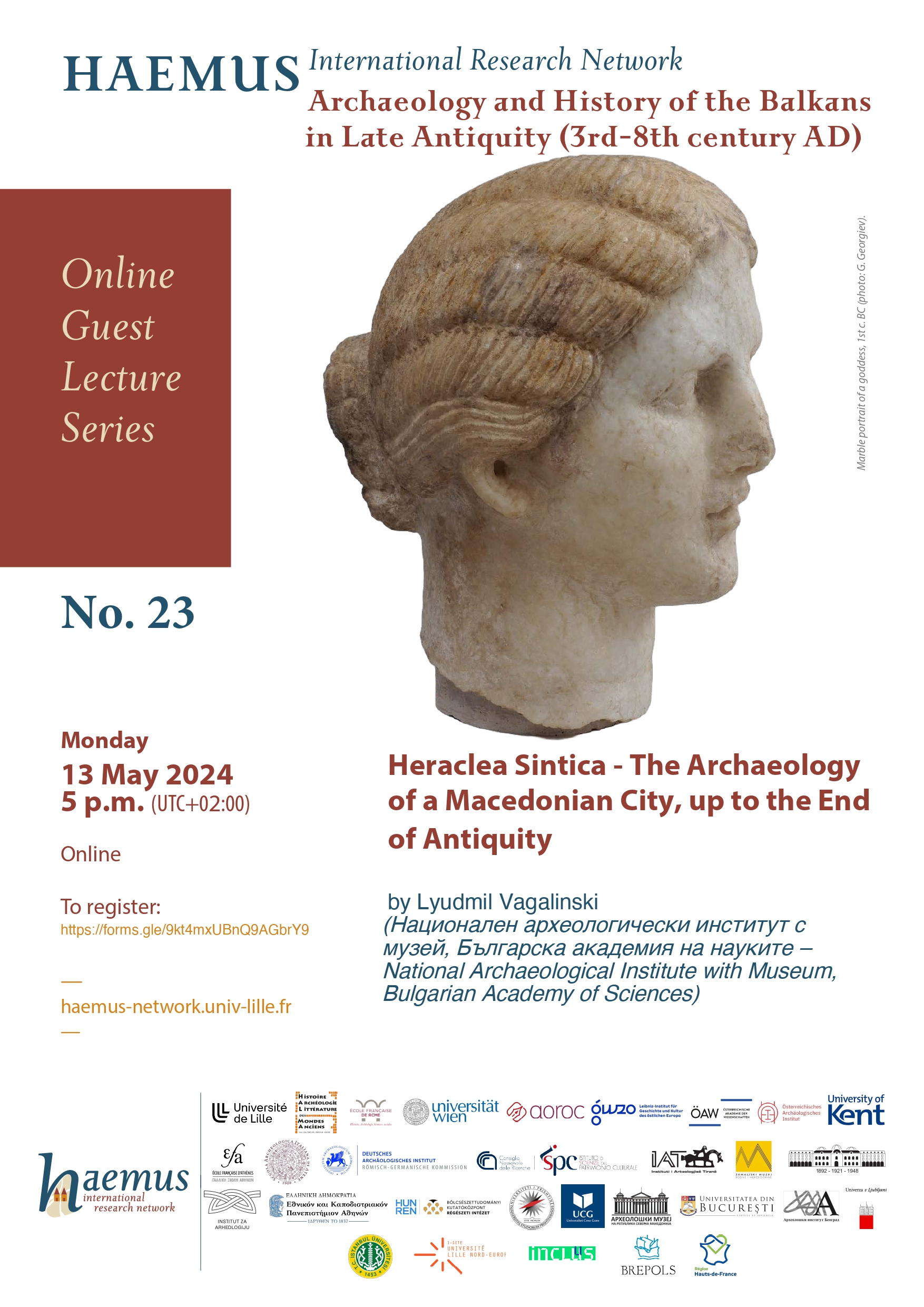
No. 22: Traces of Battles? Conjectures about Late Roman militaria from Cibalae and Mursa (15 April 2024)
by Ivan Radman-Livaja (Arheološki muzej u Zagrebu)
Abstract: According to written sources, Pannonia was clearly a land of wars in the 4th century. Ironically, the first destructions were not brought by the so-called barbarians, but by the Romans themselves: at the Battle of Cibalae between Constantine and Licinius (8 October 316), then during the war between Constantius II and Magnentius (350-353). The troops of this usurper looted all over Pannonia, conquered Siscia, and led unsuccessful sieges on Sirmium and on Mursa. The Battle of Mursa (28 September 351) went down in history as one of the most terrible of ancient times, with a huge number of casualties, supposedly 30,000 killed on Constantius’ side and 24,000 killed on Magnentius’. As a result of the disorder caused by such civil conflicts, the following decades were the theatre of many barbarian incursions south of the Middle and Lower Danube, especially from the Sarmatians, allied with the Quadi, the Goths and the Alans. It should be noted that the texts relating these events are very incomplete and confusing, but some of these people took advantage of the catastrophic Roman defeat at Adrianople to sack the then-poorly defended Pannonia. These populations might have been pushed back for a moment, but it seems that they were, in the end, allowed to settle in Pannonia, where they began to raid. It seems that Roman settlements were badly hit by these incursions and, with time, it quickly became increasingly difficult to secure a normal urban life. The general instability that took hold in the region, the severing of trade routes, as well as the decline of agriculture and economy undoubtedly induced the gradual desertion of the cities. The civil war between Magnus Maximus and Theodosius I (387-388), in which both sides hired barbarian mercenaries, finally announced the end of Roman Pannonia, as the soldiers plundered widely, and Sisca became the location of the decisive battle. Thus, the4th century ended up with the region being ravaged. Is there some archaeological evidence for the information provided by ancient authors? In fact, not as much as we would expect, but this paper will try to evaluate the data from the written sources, by presenting the relevant archaeological record possibly pertaining to the historical narrative.
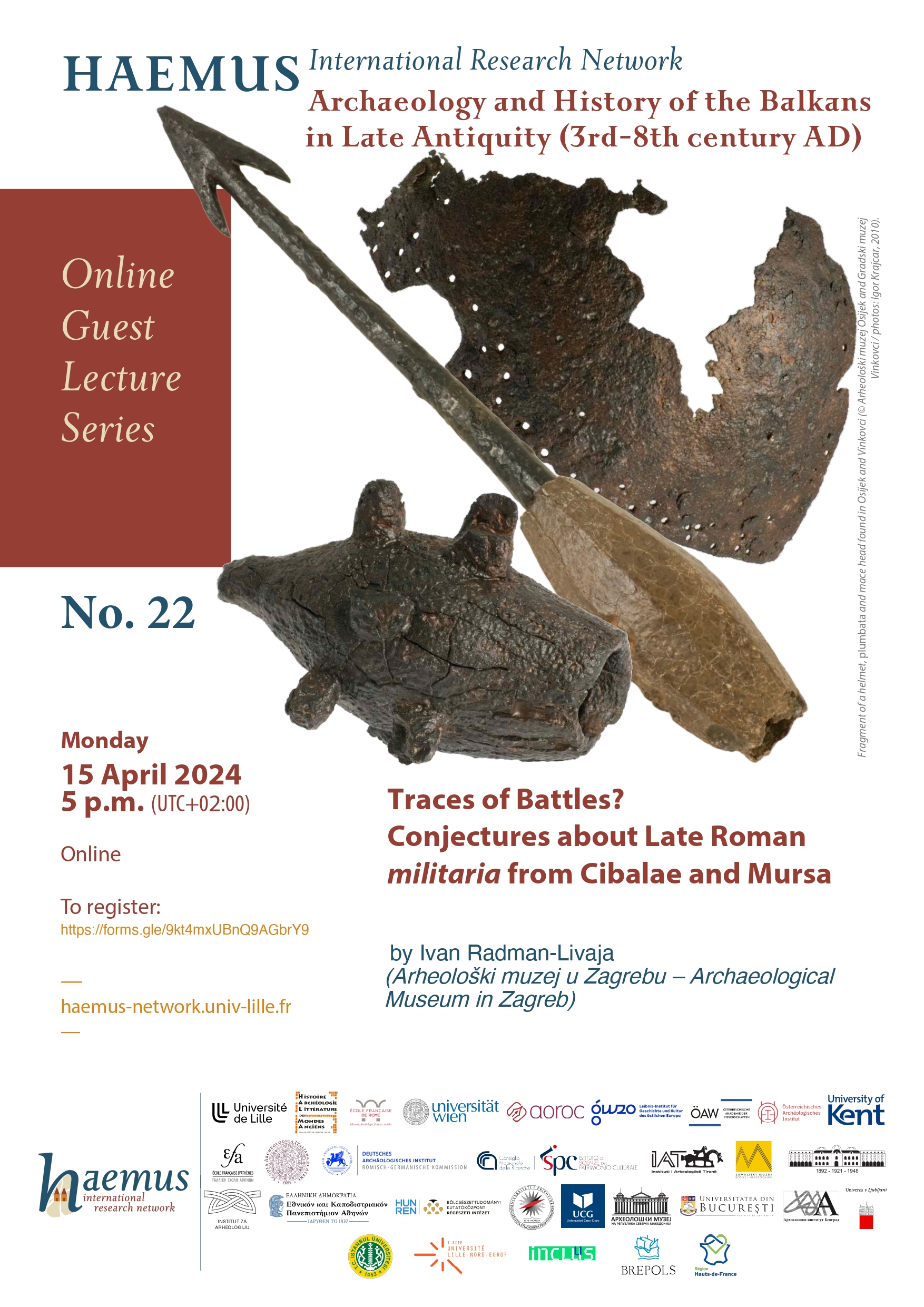
No. 21: Shifting Residential Dynamics in the Turbulent Late Antique Balkans (26 February 2024)
by Slavko Ciglenečki (Inštitut za arheologijo, Znanstvenoraziskovalni center Slovenske akademije)
Abstract: Relying on a book recently published (Between Ravenna and Constantinople. Rethinking Late Antique Settlement Patterns, Ljubljana 2023), this presentation will provide an overview of the settlement patterns during a transformative period in European history, spanning from the late 3rd to the early 7th century. During this period, cities in the Balkan continental areas were largely abandoned, or they persisted as significantly diminished, rural versions of their former selves. Other lowland settlements, especially the once-prominent Roman villae, ceased to exist by the middle of the 5th century. The population began to retreat to remote and naturally well-defended hilltop settlements with an autarchic nature, where the achievements of ancient civilisation were maintained until the late 6th century. We will not only offer here a comprehensive examination of the characteristic cities, lowland hamlets, and fortified settlements, but also interprets the profound transformation of these settlement patterns.
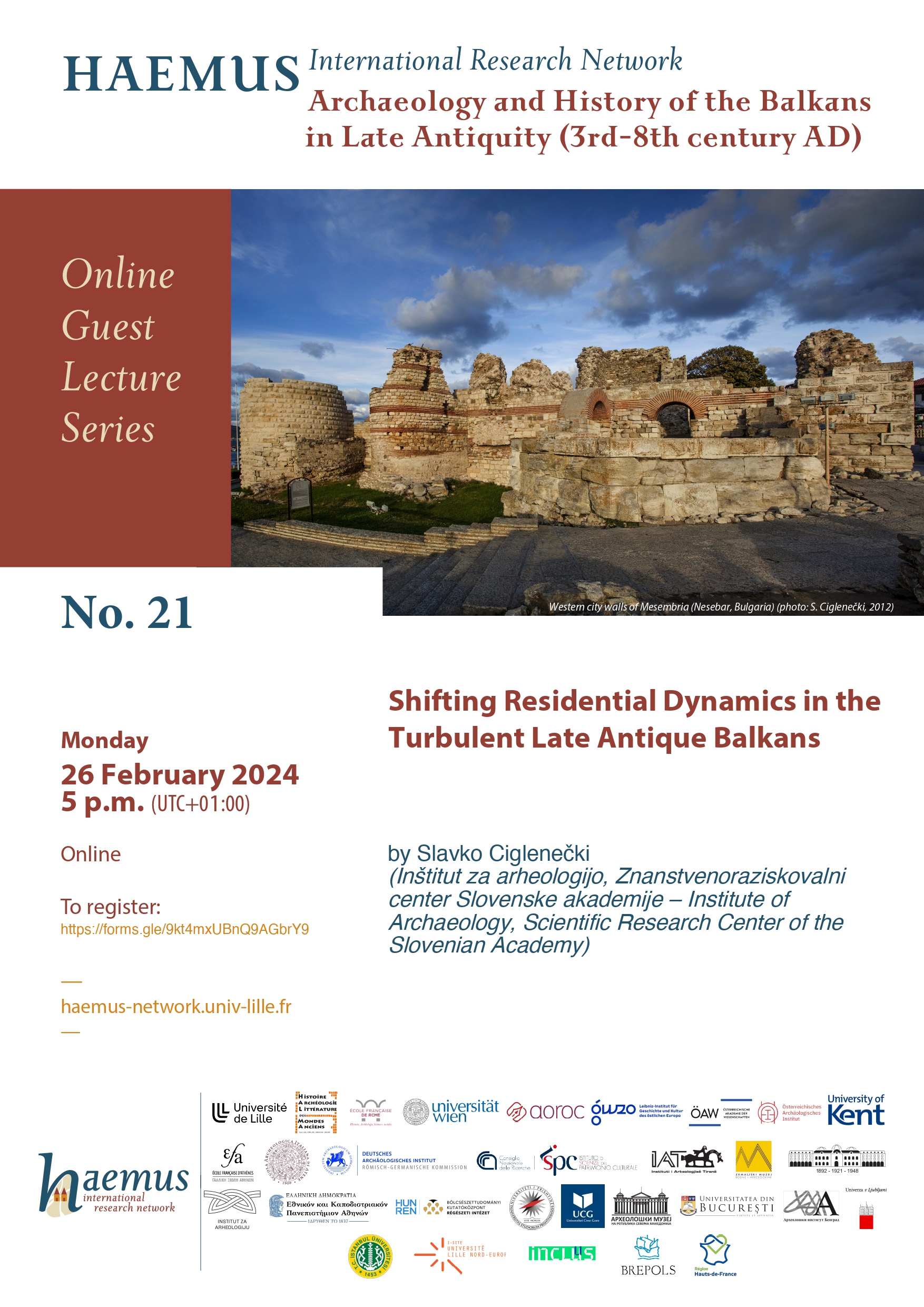
No. 20: Eastern Adriatic Church Complexes and Early Monastic Establishments: Some New Results from the MONACORALE ANR Research Project (29 January 2024)
by Sébastien Bully (CNRS, UMR 6298 – ArTeHiS) and Morana Čaušević-Bully (Université de Franche-Comté/UMR 6249 – Chrono-environnement)
Abstract: The MONACORALE (MONAsteriorum CORpus Adriaticorum et Locorum Ecclesiasticorum): History and Archaeology of the Monasteries and Ecclesiastical Sites of Istria and Dalmatia (4th-12th c.) research project is funded by the French National Research Agency (ANR), for the period between February 2021 and January 2025. It aims to renew our knowledge on ecclesiastical sites located on the Croatian coast and islands, relying on archaeological fieldwork (surveys, topographical surveys, archaeometric dating), an inventory of the former excavation records, as well as historical research through primary literary sources (this part is led by Stéphane Gioanni, Université Lumière Lyon 2 / HiSoMA-UMR 5189 research centre). For this purpose, the territory was subdivided into four broad regions, fully considering Dalmatia and the Kvarner Archipelago. This paper will, therefore, present the first results obtained on a selection of sites from two regions, and the state of the research for the first stage of the project. It will also focus on the progress of the planned excavation carried out so far, within the workshop area on the Early Christian and Mediaeval ecclesiastical complex of Martinšćica (island of Cres).

No. 19: Changes in Settlement Landscape in the Vicinity of the Iatrus Fortress on the Lower Yantra (Bulgaria) (7 December 2023)
by Sven Conrad (Eberhard Karls Universität Tübingen)
Abstract: For more than 25 years, interdisciplinary surveys have been conducted thought Bulgarian-German joint projects in the area around the Novae legionary camp and the Iatrus fortress. They revealed settlement patterns of different densities and structures for the Imperial period. For instance, the area between Novae and its vicus (approximately 2.5 km) is occupied by suburban villae. Moreover, a regular alignment of villa complexes along the edges of the valleys further south suggests a land division made by the Roman administration. At the mouth of the Yantra River, a project that has been running since 2018 has also identified extensive settlement areas along the river meanders, which may be attributed to the local population. According to the current state of research, which is based mainly on surface finds, rural settlements continued without interruption until around the second half of the 4th century. At the turn of the 4th and 5th centuries, most of these settlements and villae were abandoned, probably because of the Hunnic invasions. During the 5th and 6th centuries, the rural areas away from the fortified places were apparently only sporadically populated. With the abandonment of the Danube Limes in the wake of the Avar and Slavic invasions around 600, the Later Roman/Early Byzantine rural settlement in the region also ended.
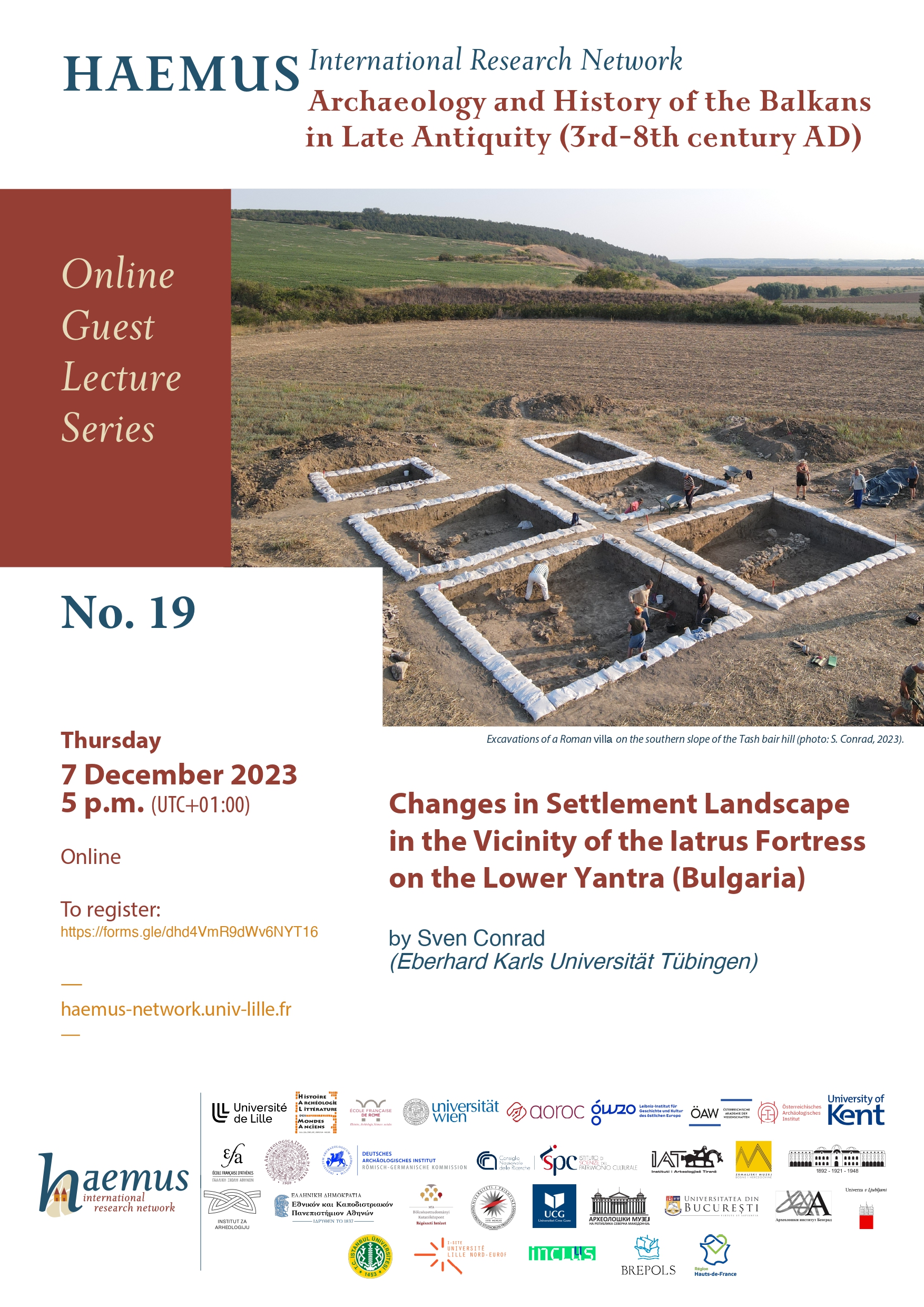
No. 18: Landscapes of Roman Arba – A Case Study of Late Antique Transformations Within the Kvarner Archipelago (Croatia) (6 November 2023)
by Ana Konestra (Institut za arheologiju – Institute of Archaeology, Zagreb) and Fabian Welc (Uniwersytet Kardynała Stefana Wyszyńskiego w Warszawie – Cardinal Stefan Wyszynski University in Warsaw)
Abstract: A decade of survey on Rab, ancient Arba, yielded a large amount of diachronic data on the settlement pattern of this medium-sized island located in the northernmost gulf of the eastern Adriatic, the Kvarner. Thanks to subsequent targeted remote sensing and trial trenching survey results were integrated and more finely tuned both chronologically and typologically. What emerges thanks to this integrated approach is a complex pattern of a Roman settlement within the countryside and the coastal belt of the island, later modified and transformed, almost as a direct, material expression of the changing times. Through this lecture we wish to explore what the materiality of these transformations is, how it can be recognised and interpreted both within the island’s settlement pattern and the single sites. Also, by placing the island within the wider Upper Adriatic and Dalmatian contexts, we wish to explore whether and how its insularity played a role in the local emergence of regionally well-documented phenomena of Late Antique transformations.
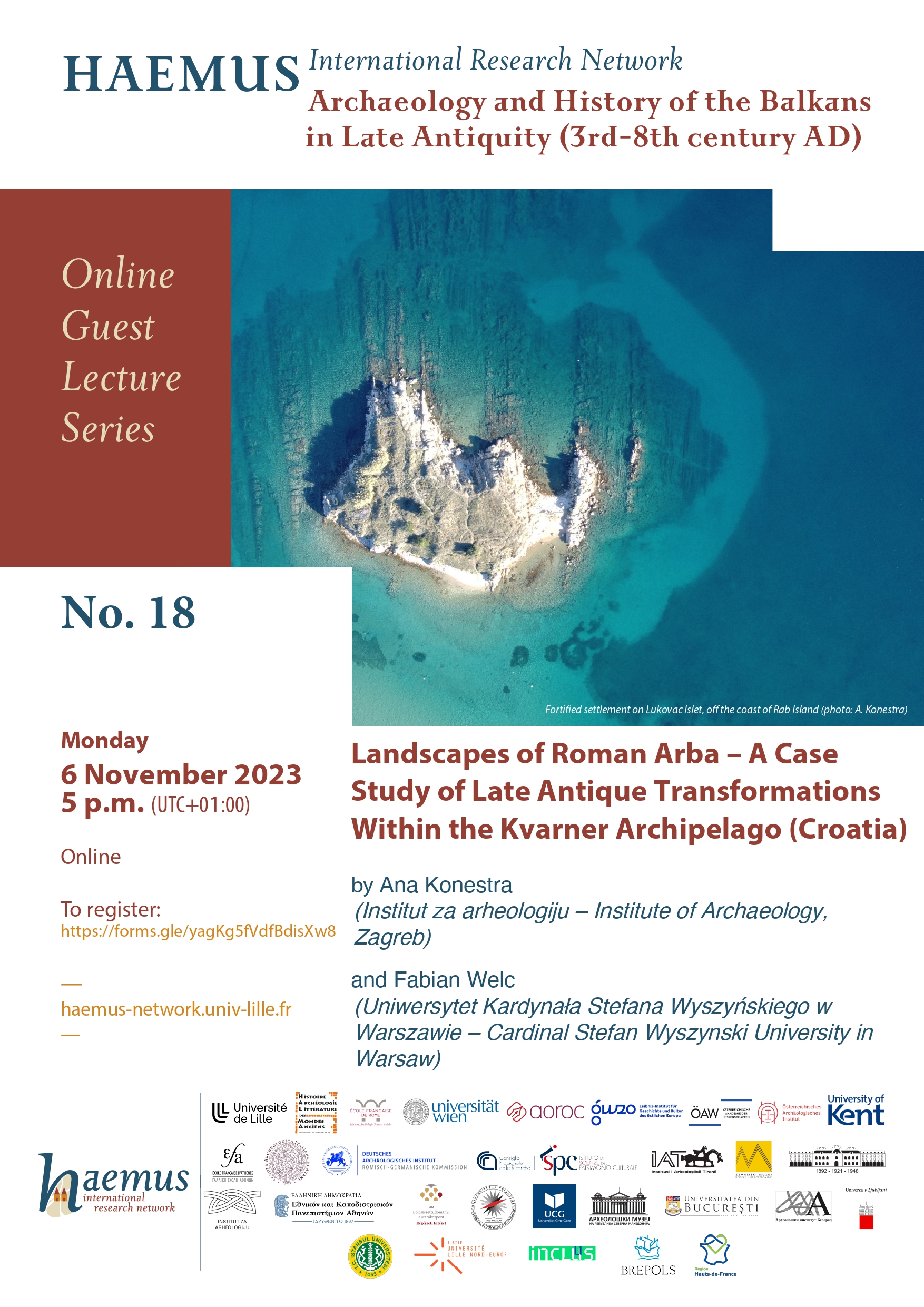
No. 17: Doclea (Montenegro) in Late Antiquity: Some Remarks from the Italian-Montenegrin Bilateral Projects (2 October 2023)
by Lucia Alberti, Carla Sfameni (CNR, Istituto di Scienze del Patrimonio Culturale) and Tatjana Koprivica (Univerzitet Crne Gore, Istorijski institut – University of Montenegro, Historical Institute)
Abstract: In 2017, a first of successive research projects was launched between the Italian National Research Council and the University of Montenegro, aiming to study the Roman city of Doclea and its territory, so far little investigated in a systematic way. Until today, an Italian-Montenegrin team has been working on this site with a multidisciplinary approach; since Doclea was excavated from the end of the nineteenth century, the new project started with the collection and the analysis of archival and epigraphic data, and then proceeded with archaeological, architectural, topographical and geophysical research. Particular attention has been paid to the transformations of topography and monuments between the Late Roman imperial period and the early Middle Ages (4th-7th c. AD). After an important building phase, to be probably placed in the times of Diocletian, other phenomena well known in other cities of Dalmatia and elsewhere in the Roman world, such as the abandonment of public buildings and their reuse with different functions, mainly artisanal, and the construction of Early Christian churches, were observed.

No. 16: Spolia, Spoliation, and Spolia-Building in the Southern Balkans: Some Preliminary Thoughts (19 June 2023)
by Luke Lavan (University of Kent)
Abstract: Spolia produces both fascination and disgust for many Roman archaeologists. How did the building blocks of so many elegant classical structures come to be incorporated in late antique walls? Why did this happen? In this paper, I propose to address some of these questions from a purely archaeological point of view, contrasting different regions, where the spolia habit takes many different forms. What can the testimony of pieces of stone contained in walls tell us about these issues, especially when considered contextually? Are we dealing with one process and one set of cultural attitudes, or many? By considering well-dated examples from across late antiquity, the spolia habit turns out to be varied and complex, both in terms of its spoliation practices and in terms of construction using spolia. Something resembling a new urban history emerges for a few sites, purely from the record of reused building materials.
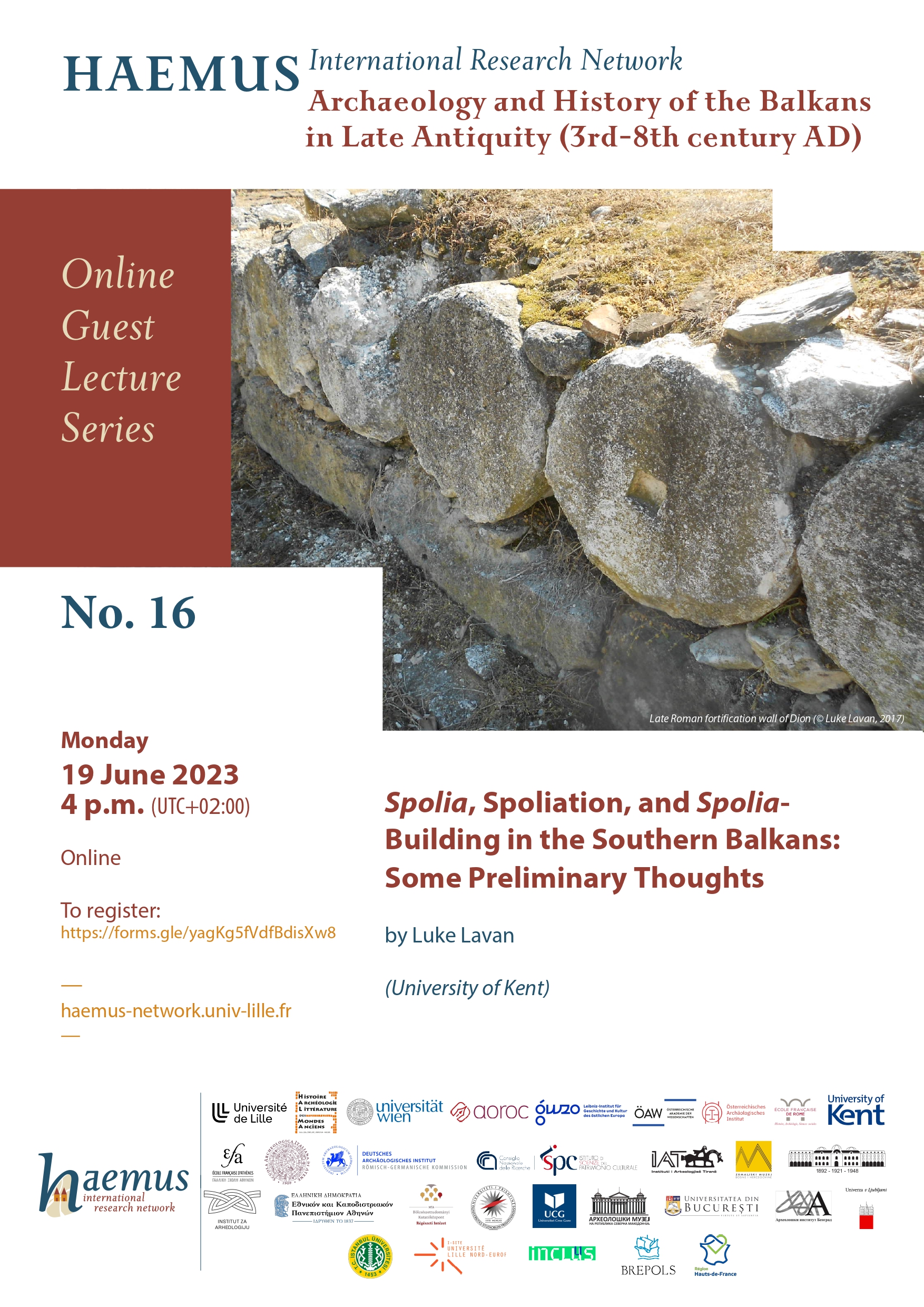
No. 15: Under Asclepius' Watchful Eye: The Transformation of the Theatre Square in the Central Urban Area of Heraclea Lyncestis (29 May 2023)
by Ljubinka Džidrova (Археолошки музеј на Република Северна Македонија – Archaeological Museum of the Republic of North Macedonia)
Abstract: This presentation focuses on an aedicula built within the scene rear of the Roman theatre at Heraclea Lyncestis. The theatre was a part of an early imperial urban complex overlooking a double portico that conducted to a spacious forum, directly to its south. Located approximately at the centre of the back of the stage and several metres higher than the forum, a modest shrine built in a vaulted chamber dominated the lower-lying urban precincts. It seems that it succeeded the position of a presumed humble pre- or Hellenistic place of worship linked to the groves of Bukovo (this toponym refers to a beech grove). Originated at an uncertain moment, in an earlier Antiquity, it probably obtained its fame from the natural environment, thickly grown with beech trees where a local cult dedicated to Asclepius later occurred. It became subject to intensive development from the 4th c. AD – yet, not fully demonstrated by excavation results –, but the following troubled period didn’t prevent the growth of the site. It even stimulated it, first with its development into a modest hospice and soon afterwards into a xenodocheion that engaged almost completely the so-called theatre square. Until its final ruin, most probably in the late 6th c., the sacred place changed its patron for a Christian one, while the healing tradition and practices fulfilled at the site during past centuries were revived during the Middle Ages.
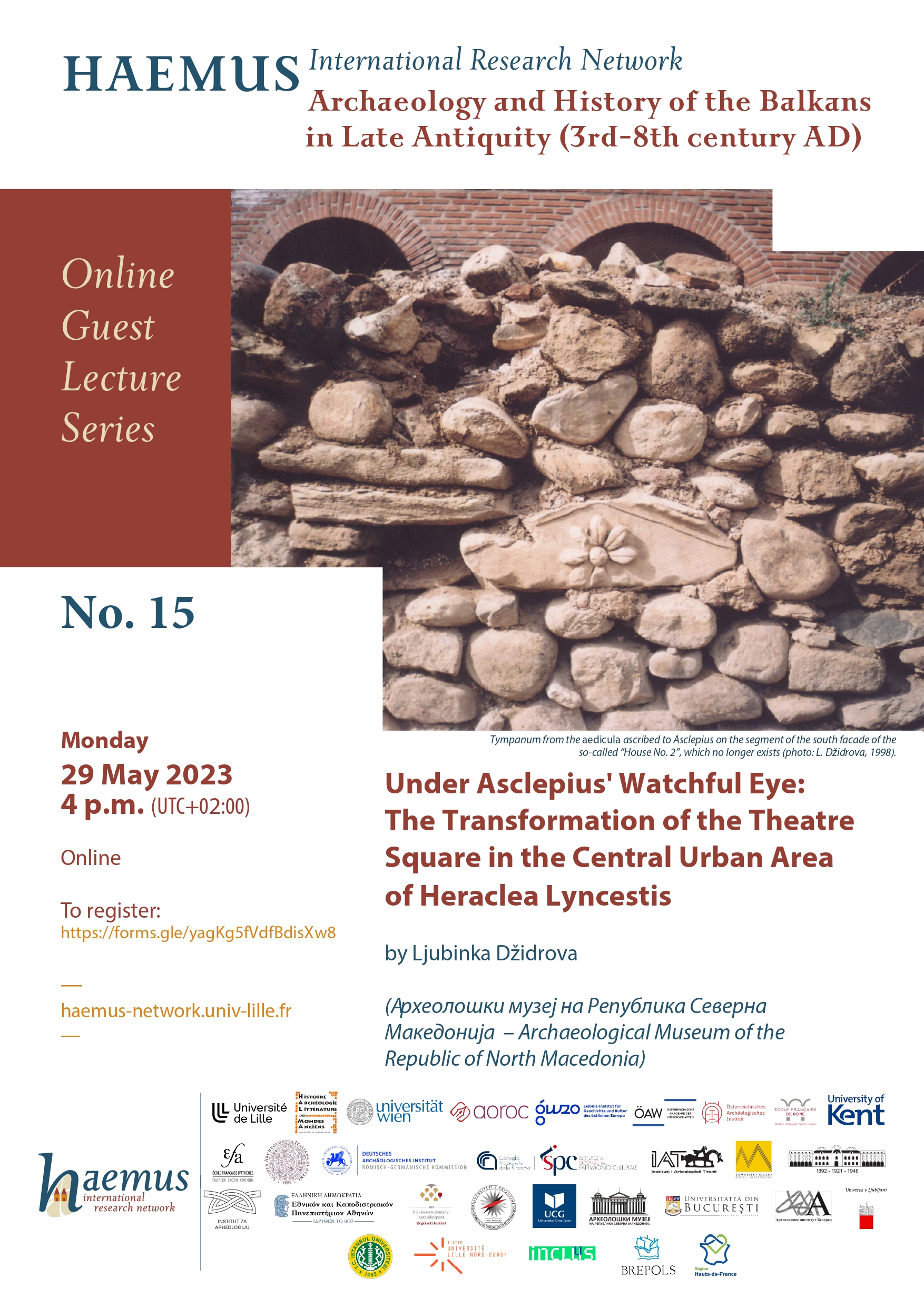
No. 14: In and Out! Patterns of Hoarding in Pre-, During- and Post-Roman Dacia and the Lower Danube Region (27 March 2023)
by Cristian Găzdac (Universitatea Babeș-Bolyai – Babeș-Bolyai University, Cluj-Napoca)
Abstract: Until now, the research on hoards has been limited by the access to the publications, which in most of the cases, were restricted to a certain territory. At the same time, the large territory and the long duration of the Roman Empire presented challenges for establishing general and specific patterns of coin hoarding. The project run by the Ashmolean Museum and the Oxford Roman Economy Project (University of Oxford), together with a continually growing network of collaborators, has created the largest database of coin hoards of the Roman Empire. This paper intends to point out general and specific patterns of the coin circulation in Dacia (mainly nowadays Romania). The chronological frame has been chosen according to both historical background of the territory of Dacia and the interest on coin hoarding. It is a well-known fact that the Roman republican denarius was highly present on the Dacian territory in the 1st century BC – 1st century AD. Dacia became a Roman province under the reign of Trajan, was under the Roman administration until the 2nd half of the 3rd century AD, and was partially re-conquered by Constantine I. The changes of status mean that the pattern of coin hoarding on such a large territory is potentially of interest for both coin circulation as well as frontier studies. In this paper an attempt is made to analyse possible patterns of coin hoarding between different regions of Dacia before, during and after the Roman administration in this area. The paper intends to address aspects such as: the concentration area and chronological patterns of hoarding; hoarding behaviour; and patterns of hoarding of specific coinages/denominations.

No. 13: The South-East Periphery of the Khaganate – Communication Key of Late Antique Influence (30 January 2023)
by Pia Šmalcelj Novaković (Institut za arheologiju – Institute of Archaeology, Zagreb)
Abstract: Western Syrmia, which is located on the very border of Central Europe and the Balkans, is traditionally considered a part of the south-east periphery of the eighth-century Avar Khaganate. Even if the region is in under “barbarian” control, archaeological and historical indications highlight the legitimacy of the theories on the strong influence of Late Antique provincial/Mediterranean culture in the region. This may be observed through the “survival” of certain activities and/or skills (e.g. goldsmithing), and a great receptivity of the population of these areas to the Mediterranean “fashion” or cultural expression. This could also be witnessed through indications of an increased communication of this area with the East, possibly for the sake of trade.Thus, the term “periphery”—which is often used in studies describing the Avar cultural circles—applied not only to Western Syrmia, but also the whole of the south-eastern part of the Khaganate, with regards to the Byzantine cultural circles, becomes ambiguous, as the region could represent one of the keys to understand the cultural influences at a lower social level than the elite in the Early Mediaeval Carpathian Basin. In this lecture, we will focus on this issue, by relying on the concrete example of two Late Avar cemeteries, through the analyse of the broader archaeological and historical context. This presentation is part of the activities of the project “Life on the Roman Road: Communications, Trade and Identities on Roman Roads in Croatia from 1st – 8th CE” (UIP-05-2017-9768) of the Institute of Archaeology in Zagreb, funded by Croatian Science Foundation, under the leadership of Ivana Ožanić Roguljić.

No. 12: The Transformations of Scupi: From the Roman Imperial Colony to the Mediaeval Settlement (9 December 2022)
by Lenče Jovanova and Igor Kuzmanoski (Mузеј на град Скопје – Museum of the City of Skopje)
Abstract: This paper will attempt to present Scupi’s complex development, from the original agglomeration, with an unknown status, to the prosperous imperial colony, then from the Late Roman provincial metropolis and episcopal see to the Early Mediaeval modest rural settlement. The characteristics and elements suggest two main urban stages: 1- from late 1st c. to late 4th/mid-5th c.; 2- from middle/late 5th c. to late 6th c., this later phase being marked by Christianity. Since its establishment as a veteran colony, Scupi retained its basic orthogonal urban structure, viz. with a similar layout of streets and buildings, as far as the first decades of Late Antiquity. Later, during the 5th and 6th centuries, the city experienced a complete transformation, through a reduction of its size, changes in urban composition and aesthetics, as well as an exponential predominance of Church buildings in its public space. After a blank period, the territory of Scupi had a brief revival during the Middle Ages (9th-11th centuries), as attested by a rural settlement and burials.
No. 11: Aspects of the Transformation of Early Mediaeval Dyrrachium (2 December 2022)
by Brikena Shkodra-Rrugia (Instituti i Arkeologjisë, Akademia e Studimeve Albanologjike – Institute of Archaeology, Academy of Albanian Studies)
Abstract: Not relying on stratified archaeological evidence, the traditional approach to the Early Mediaeval Dyrrachium presents it as a no-longer-flourishing city, with abandoned civic monuments, and its widespread urban graves as the only trace of human activity. This unfounded theory creates a distorted image of urban and social life during the 7th and 8th centuries. Recent stratigraphic studies, combined with thorough excavations of all archaeological layers, allowed a more satisfying picture of the Early Mediaeval settlement and its material features. This new research offers, thus, the initial basis for a new perception of Dyrrachium during its transition from Late Antiquity to Middle Ages. This paper aims to examine some of the features characterising this period of great transformations for the city.
No. 10: Sanctuaries in Roman Central Balkans between Antiquity and Late Antiquity (21 October 2022)
by Nadežda Gavrilović Vitas (Археолошки институт, Београд – Archaeological Institute, Belgrade)
Abstract: The topic of sanctuaries in the territory of Roman Central Balkans is very complex, for various reasons that stand in the way of encompassing, analysing and interpreting archaeological remains in spaces which are identified as sacred. Consequently, this theme hasn’t been explored thoroughly in this region and no synthesis, which would show the abundance and diversity of sanctuaries and temple buildings (templum, aedes, sacellum, fanum, delubra, spelaeum, sacrarium), has been yet published on it, although the numerous sources could allow us to offer a quite precise picture. For example, a large number of votive inscriptions tell us about the existence of cult places or simply a sacral space dedicated to one or more deities. Due to unsystematic archaeological excavations, unpublished or lost documentation, and not preserved archaeological monuments, only 13 mentions of templum, 2 mentions of aedes and 1 mention of fanum are remaining. Nevertheless, thanks to indirect testimonies about the existence of sanctuaries and sacral spaces, in particular in urban or rural centre (like, for instance, architectural parts of temples found as spolia), we have a richer documentation than one might expect at first sight, not only about the buildings and other infrastructure, but also the worshippers and ritual practices performed, between Antiquity and Late Antiquity.
No. 9: Iron Production Along the Drava River in the Roman Period and the Middle Ages (7 October 2022)
by Tena Karavidović and Tajana Sekelj Ivančan (Institut za arheologiju – Institute of Archaeology, Zagreb)
Abstract: The research presented in this paper explores the evidence and nature of iron production in the lowland area of the central Drava River Basin, in Croatia, from the 4th to the early 9th century AD. The archaeological records of this industry are analysed through an interdisciplinary approach which examines the technology used as well as the natural resources exploited in the production process (bog iron ores, wood and plant remains). The results highlight to the importance and longevity of iron production in the area of the Drava Valley, not only in terms of continuity, but also of technological development, during Late Antiquity and the Early Middle Ages.
No. 8: From Roman to Late Antique Butrint: The Evidence on Houses and the Topography of Urban Quarters (9 September 2022)
by Nevila Molla (Instituti i Arkeologjisë, Akademia e Studimeve Albanologjike – Institute of Archaeology, Academy of Albanian Studies)
Abstract: Butrint, a multi-period urban settlement on the Ionian coast of south-west Albania, offers ample archaeological evidence on the change and transformation of the Mediterranean city at the end of the Roman period. Recent archaeological excavations in the peninsular lower town area of the so-called Triconch Palace, and on the Vrina Plain suburb on the southern side of the Vivari Channel, inform this subject from the perspective of secular residential buildings. Now published, these excavations chart the development and transformation phases of two large residential complexes from their construction in the early and late Roman imperial periods to their abandonment as areas of human activity in the late medieval period. This presentation will discuss the urban fabric of Butrint in the late antique period (c. AD300 to c. AD600) in the light of the evidence from these excavated domus, pieced together with other fragmentary clues on houses and associated residential facilities elsewhere at the site. Among the few known and archaeologically investigated examples in Albania and in the Balkans, the construction of these domus and their transformation in the late antique period shed light on the nature of houses and house-building, and on the overall changing topography of a small, but significant port-town that enjoyed trade and economic ties with the Adriatic and the wider Mediterranean region.
No. 7: Square and Rectangular Isolated Towers in Late Roman Dalmatia (27 May 2022)
by Josipa Baraka Perica (Sveučilište u Zadru – University of Zadar)
Abstract: The construction of towers in Late Roman Dalmatia is associated with the process of fortification, with the aim of establishing a defence line in protecting major communication routes, both on sea and land. Such a network of fortified settlements along the Eastern Adriatic coast and in Roman Dalmatia is usually referred to as a limes and it is associated with the idea of an imperial renewal during Justinian’s era. The strongholds that were a part of this system are testimonies of different architectural solutions: from sites that can be considered as genuine Byzantine towns to simple towers. This lecture will offer an overview of the archaeological sites on which square and rectangular isolated towers from Late Antiquity can be found. Their similarities in terms of architectural form suggest that they are the result of a well-planned project. In addition to their general plan, they also share a location on a highly strategical position, almost always close to an existing settlement.
No. 6: Long Walls and Linear Barriers in the Balkan Provinces (29 April 2022)
by Jim Crow (University of Edinburgh) and Efthymios Rizos (Εφορεία Αρχαιοτήτων Σερρών – Ephorate of Antiquities of Serres)
Abstract: This paper discusses the use of landscape fortification features at narrow passes and isthmuses, based on Procopius’ account about the Balkans in the fourth book of the Buildings. These are the pass of Thermopylae in Boeotia and the nearby mountain pass of Heraclea, the wall of the Corinthian Isthmus, the isthmus wall of the Pallene peninsula at Cassandrea in the Chalcidica, the Anastasian Long Walls of Constantinople, the Long Walls of the Thracian Chersonese, and the cross walls of Anastasiopolis and Topirus on the Via Egnatia. Based on the fact that most of these places are known to have been fortified in pre-Roman times, this paper will discuss when and how the late Roman army started to be interested in making use of them. It is argued that long walls started to be revived during the third-century crisis, but they acquired greater strategic significance under the Theodosian Emperors and down to the end of Antiquity. Most of them were maintained and used throughout the Byzantine period.
No. 5: Recent Research by the University of Bucharest on the Acropolis of Istros/Histria (Romania) (28 March 2022)
by Valentin-Victor Bottez, Alexandra Țârlea and Iulia Iliescu (Universitatea din București – University of Bucharest)
Abstract: This presentation will focus on the research undertaken by the University of Bucharest on the Acropolis Centre-South (ACS) Sector in Istros/Histria (Constanța County, Romania). Apart from basic information about the project itself (objectives, methodology, expected results, dissemination), we will present the Late Roman insula (6th-7th c. AD) we are currently investigating, namely its structure, stratigraphy, chronology and integration in the city’s Late Roman urban plan. The second part will be devoted to a brief overview of the investigations to which various categories of the archaeological material from the ACS Sector were subjected so far. The use of compositional analyses based on methods such as XRF (metal), PGAA (glass), and PIGE (ceramics), electronic microscopy and tomography for offering insights into patterns of production, technologies and consumption trends will be discussed. The third part will constitute a preliminary report on the ceramic material discovered on the sector. Even though the research is not yet complete, the data obtained so far represent solid evidence for the economic life and cultural contacts that characterised the ancient city of Istros/Histria during Late Antiquity. From a chronological perspective, the analysis of the ceramic material allowed us to establish more clearly the functioning period of our complex.
No. 4: The Roman Frontier in Serbia – Image of the Past and Vision for the Future (25 February 2022)
by Nemanja Mrđić (Археолошки институт Београд – Archaeological Institute, Belgrade)
Abstract: The part of the frontiers of the Roman Empire that goes through Serbia is one of the most impressive sections of the limes and one of the longer ones. Although during the sixties and seventies of 20th century rescue excavations linked to the construction of Djerdap I and II were among the largest in Europe, the important discoveries made during them were almost completely forgotten afterwards. It’s only with the project of a nomination to the UNESCO World Heritage List that researchers started again to take a real interest in the Danubian limes and that they considered it as an essential part of the Roman heritage in Serbia. Thus, its archaeological sites are now thoroughly excavated, preserved and presented, especially through archaeological parks which aim to make them better known to tourists. Some of the most important sites that were submerged in the Iron Gate, considered to be destroyed by the force of the Danube, are even now again in the focus after being 50 years under the surface, and surprisingly they are still standing.
No. 3: Early Byzantine Military Equipment from the site of Biograci (Bosnia and Herzegovina) (10 December 2021)
by Adisa Lepić (Земаљски музеј Босне и Херцеговине – National Museum of Bosnia and Herzegovina)
Abstract: The systematic excavations of Gradina in Biograci near Lištica, west Hezeovina which were carried out during 1969 and 1970 under the leadership of Dr. Irma Čremošnik, resulted in the inclusion of a valuable site on the archaeological map of Bosnia and Herzegovina. According to the research of that time, Biograci was primarily interpreted as a Roman fortification dating from the 2nd-4th century, linked to a hilltop settlement with an Avar-Slavic phase. A recent reconsideration of the material kept within the Classical Antiquity collection of the National Museum of Bosnia and Herzegovina allowed the identification of finds from the early Byzantine and the Migration periods. Among them, there is a fragmented cheek flaps (paragnatide) from the Narona / Baldeinheim type helmet. The paper will be dedicated to the professional and scientific processing of the bronze sheet metal plate with traces of gilding, which, through comparison with the complete findings of helmets of the same type, was identified as part of our helmet. We will also look at the remaining parts of a lamellar armour also of the early Byzantine era. The appearance of the so-called western group of helmets known as the Narona / Baldeinheim type is extremely rare for the Migration period, while no helmet of this type has been found elsewhere in Bosnia and Herzegovina so far. The situation is the same with the lamellar armour.
No. 2: The Roman Legionary Camp and Early Byzantine Town of Novae (Moesia Inferior/Moesia Secunda): 60 Years of Research or How We Are Doing 60 Years Later (22 October 2021)
by Elena Klenina and Andrzej B. Biernacki (Uniwersytet im. Adama Mickiewicza w Poznaniu – Adam Mickiewicz University in Poznań)
Abstract: The Roman camp and Early Byzantine city of Novae (Moesia Inferior/Moesia Secunda) on the southern bank of the Danube River was the most important centre on the border of the Empire. During the long-time Polish-Bulgarian archaeological and interdisciplinary studies which began in the 1960s have made it possible to identify and analyse several elements constituting its urban and architectural uniqueness. The excavations in the central and western part of Novae are now undertaken within the framework of the Polish-Bulgarian scientific-research project headed by Evgenia Gencheva (NAIM-BAN, Sofia), Andrzej B. Biernacki and Elena Klenina (AMU of Poznań). The reconstruction of Novae started after the conclusion of the peace treaty in 382 with Goths. The Roman military camp was then reorganised into a city that expanded toward the east. Various workshops, which before had been located outside the defensive walls, were relocated inside the fortress. The urban population was only partly civilian, as the military administration and the legionaries were still living on the site. The establishment in the early-5th century of an episcopal see was also a significant event in the history of Novae. However, the most important event of the same century, which brought the most radical changes, was the attempt by the Goths, led by Theodoric, to establish the capital of their state in Novae. In the 6th century, Novae was a famous Christian centre in the Lower Danubian region. For example, the description of the entry of Petrus, the brother of Emperor Maurice (582–601), in Novae in 597, on the eve of the martyr Luppos, informs us about the importance of this saint in the region. Furthermore, the city remained an important centre for trade, craft, and religion until its abandonment in the early 7th century.
No. 1: Caričin Grad: New Insights into a 6th-Century City (18 June 2021)
by Vujadin Ivanišević (Археолошки институт, Београд – Archaeological Institute, Belgrade) and Catherine Vanderheyde (Université de Strasbourg/UMR 7044 – ARCHIMÈDE and Université libre de Bruxelles)
Abstract: Although the excavations have been going on for more than 100 years, the latest research in Caričin Grad (Justiniana Prima) has provided new data concerning the city's urban planning, the new basilicas and buildings, the large suburbs, as well as the fortresses and churches in the neighbourhoods and the route of the city's aqueduct. Important information on daily life were acquired through the excavation of large parts of the city's residential areas and the study of archaeozoological, archaeobotanical and archaeopedological remains. The new geophysical surveys and the latest excavations have provided new data concerning the first planning of the city, followed by the changes in urban layout and the settlement of new populations in the city. One of the most important results is the understanding of the latest strata of urban life. Research has revealed extensive destruction at the very end of the 6th century and restoration of buildings at the beginning of the 7th century, all dated by numerous coin finds. These changes were followed by a radical impoverishment of city life and the desertion of the settlement during the first half of the 7th century. The new project launched in 2019, which concerns the excavation of the Tetraconch discovered in the Lower city, will focus on the function of this important church and on its integration into the town's urban planning, as well as on understanding the brief existence of one of the most intriguing cities located in the heart of Illyricum.




